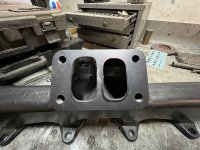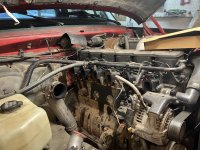One of the other issue with these trucks, is the restrictive exhaust manifold. We can tap into something called drive pressure. The high pressure leaving the engine, will drive the turbo. This drive pressure should hit the turbo at the same psi that it leaves the exhaust valve. However, the exhaust manifold is restrictive so, and so you have a loss of pressure, hitting the turbine, which means a loss of power, but also. means the exhaust is getting backed up at the exhaust valve, which means it can't flow out of the cylinder, fast enough, which means fresh air can't flow in efficiently, Which means the intercooler system can't be efficient, which means the turbos compressor has to work hard, which puts more strain on the turbine, which creates a further build up of pressure.... You beginning to see how much everything relates? Anything that doesn't improve airflow, decreases power.
So, I researched exhaust manifolds and landed on the Steed Speed website. They're a company in British Columbia, So on one of my road trips through Kelowna, I stopped in at their factory, and had a tour. I left having ordered a manifold, as I was convinced this would be the best manifold on the market, and my research of peoples experience, supports this. Yes, it improved the engine, I noticed it right away. Both seat of the pants and audibly. Turbo flashed up quicker, which meant better power off the line, and it could deal with the greater volume of flow in the top end. I just loved the way this engine sounded with the new manifold. Less crunchy, and more smooth. It also allowed me to install an EGT gauge for the first time. Highway temps with no load at 100kph, I was seeing around 600F. With the camper, about 650F at the same speed. This engine runs cool, I am happy. Going up hills, I can hit 1000F for a moment, but that tolerable.
I kept having a serious issue with the turbo. It just wasn't cracked up for running well with all these mods. Turbo surge, is a deadly (to the turbo) occurrence that happens when something is out of balance. What turbo surge is, Is when the turbo physically doesn't have the flow characteristics, to push volume and pressure into the engine. So that built pressure, tries to come back through the compressor to atmosphere with a loud chuffing sound. This would happen when I was at lower RPM, in 3rd or 4th gear, and under load. I kept backing the fuel off to try and make it go away, but to no avail. The turbo was just not well matched to the engine with all the mods. So, I installed an HX35, From a 2nd generation 12 valve, and all the problems went away. The differences between the turbos is kind of hilarious. The compressor wheel is 2mm bigger, and the turbine wheel is the exact same. The compressor housing supports better flow, and the turbine housing is smaller to promote faster spool. The turbo also has a waste gate, so in higher rpm, it still will flow properly, but also control the turbine shaft speed. This was an excellent upgrade, in my opinion, though, a good number of cummins guys think I should have gone with a bigger turbo. Maybe, but my compressor surge was gone.

The Brand new Steed Speed Manifold.

I had the nerve to gasket match it.... I suppose I can't leave well enough alone, if there's potential for a small mount of improvement.

The finished product on the manifold side.

Yes, I did the turbo too.


And a Fresh manifold installed in the cleanest engine bay on the planet. What can I say, It's a work truck. As long as its all there right?






